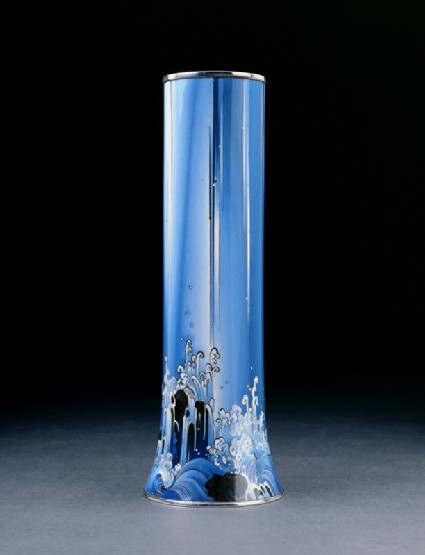Browse: 103 objects
- Reference URL
Actions
Vase with waterfall over rocks
-
Description
Namikawa Yasuyuki (1845-1927) was perhaps the most celebrated enameller of the Meiji period (1868-1912), when cloisonné enamelling reached its peak in Japan. At this time the government were encouraging artists to create works for national and international exhibitions. As standards improved, cloisonné became a popular export item. Yasuyuki founded a hugely successful workshop in Kyoto and won many gold and silver medals at almost all the great International Expositions. In 1896 he was nominated an ‘Imperial Artist’.
This vase is predominantly cylindrical in shape, widening at the base where the waterfall foams over rocks and plants. It is mainly sculpted in silver wire on shades of blue enamel, but also uses some shakudō wire, and brown and green enamel for rocks and leaves. Yasuyuki made this vase shortly before he retired in 1915.
In traditional cloisonné, wires are attached to a metal body and coloured enamels are applied between the wires. Yasuyuki’s great skill lay in the way he sculpted the wires into different shapes and widths, so that they became an important part of the picture in themselves.
-
Details
- Associated place
- Date
- 1910 - 1915
- Artist/maker
-
Namikawa Yasuyuki (1845 - 1927)
- Material and technique
- metal, with shakudō, and inlaid with silver wire cloisonné enamel
- Dimensions
-
24.9 cm (height)
6.2 cm (diameter)
at base 8.5 cm (diameter)
- Material index
-
processed material › metal › alloy › copper alloy › shakudō,
- Technique index
- Object type index
- No. of items
- 1
- Credit line
- Purchased with the assistance of an anonymous benefactor, 2002.
- Accession no.
- EA2002.177
-
Further reading
Impey, Oliver, and Joyce Seaman, Japanese Decorative Arts of the Meiji Period 1868-1912, Ashmolean Handbooks (Oxford: Ashmolean Museum, 2005), no. 38 on p. 80, pp. 8 & 22, illus. pp. 80-81
Oxford: Ashmolean Museum, 24 May 2006-23 December 2008, Treasures: Antiquities, Eastern Art, Coins, and Casts: Exhibition Guide, Rune Frederiksen, ed. (Oxford: Ashmolean Museum, 2006), no. 123 on p. 45, illus. p. 45
Glossary (2)
cloisonné, shakudō
-
cloisonné
Decorative technique in which wires are attached to a metal body and coloured enamels are applied between the wires.
-
shakudō
alloy of copper and gold, patinated to a dark blue-black colour
Location
Objects are sometimes moved to a different location. Our object location data is usually updated on a monthly basis. Contact the Jameel Study Centre if you are planning to visit the museum to see a particular object on display, or would like to arrange an appointment to see an object in our reserve collections.
Collection trails
Galleries
Publications online
-

Japanese Decorative Arts of the Meiji Period
Vase of almost cylindrical shape, widening at the base with a waterfall over rocks and plants mainly in sculpted silver wire on shades of blue enamel but with some shakudō wire and brown and green rocks and leaves. Engraved signature: Kyōto Namikawa.
Shortly before he retired in 1915, Yasuyuki was becoming too old-fashioned for the changing market in cloisonné; standards in general were dropping, as a cheaper product, superficially of fine quality, but actually much less well-made, filled an increasingly international mass market. Yasuyuki refused to compromise, and during this period produced some of his finest and most monumental work. The waterfall vase shows his mastery of the subtle use of both wire and of colour and of the adaptation of decoration to form. He had won innumerable gold and silver medals at almost all of the great International Expositions, and in 1896 he had been nominated an 'Imperial Artist'.
© 2013 University of Oxford - Ashmolean Museum






